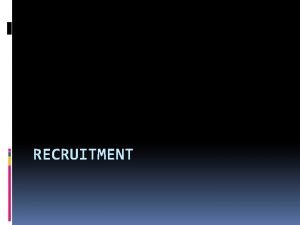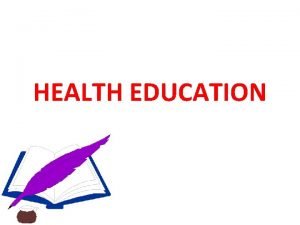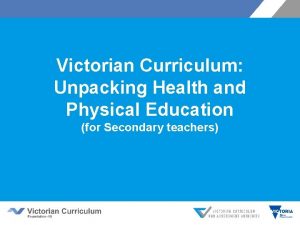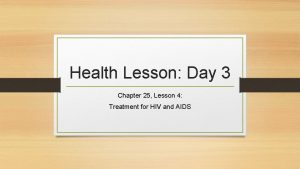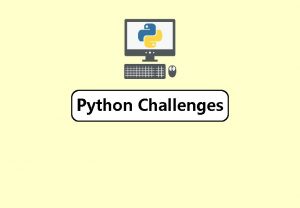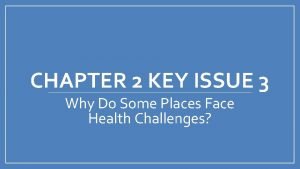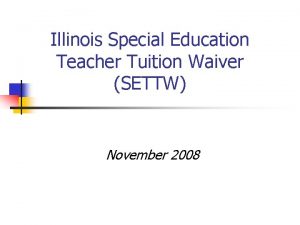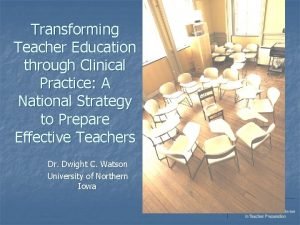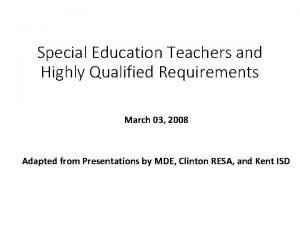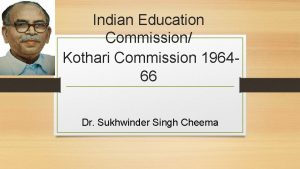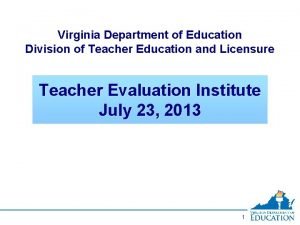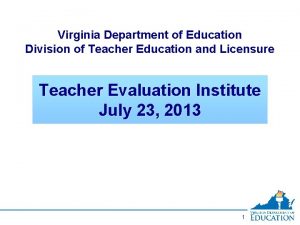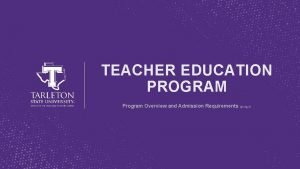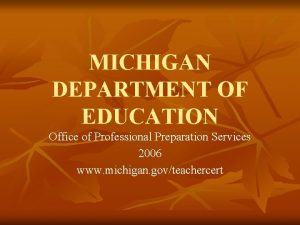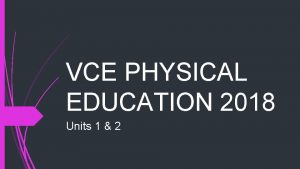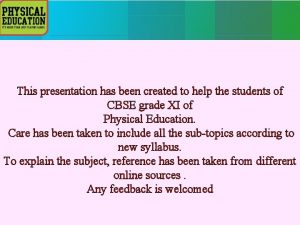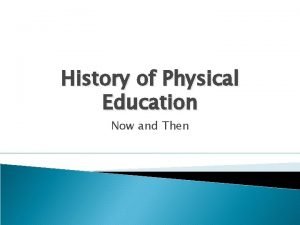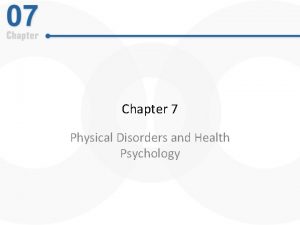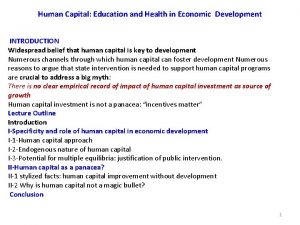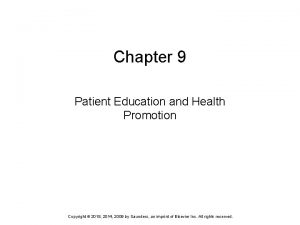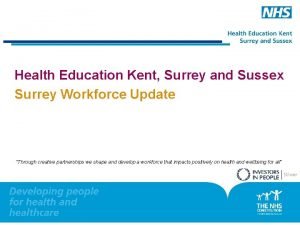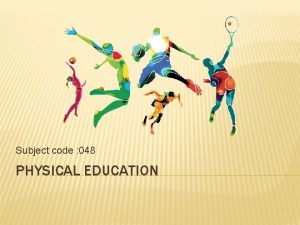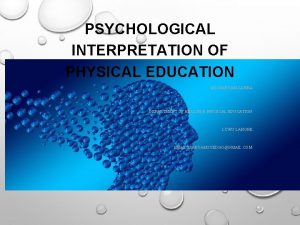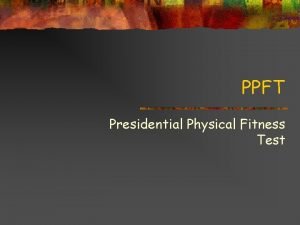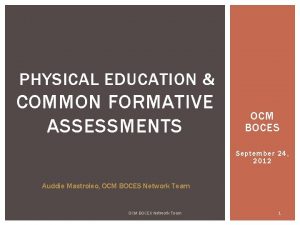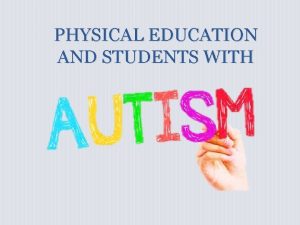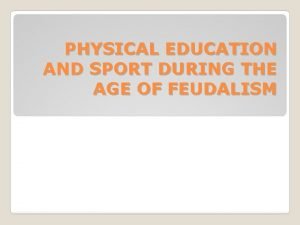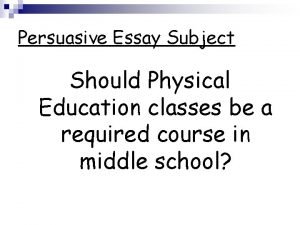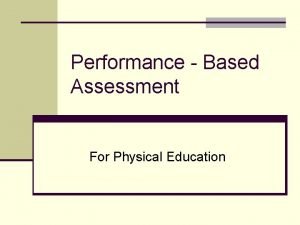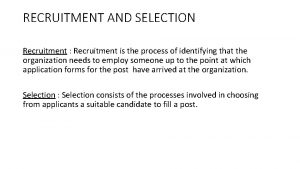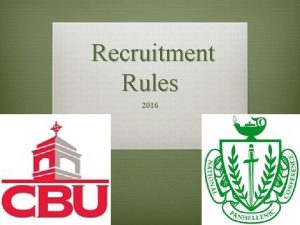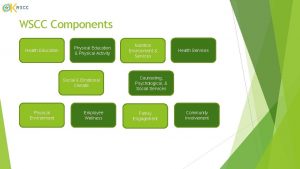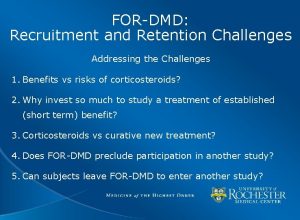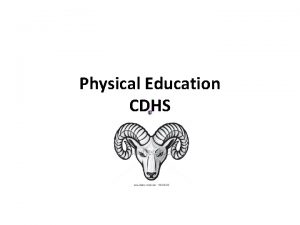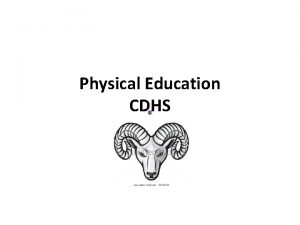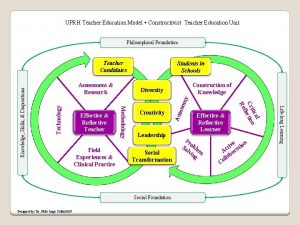HEALTH AND PHYSICAL EDUCATION TEACHER RECRUITMENT CHALLENGES AND































































- Slides: 63

HEALTH AND PHYSICAL EDUCATION TEACHER RECRUITMENT: CHALLENGES AND DIRECTIONS FORWARD

The Teacher Pipeline Fiscal Viability Quality Programs Admissions Challenges • Fewer new teachers • Reduction in pupil teacher ratios • Increased pupil enrolments • High teacher attrition Pressure Points Recruitment and Enrolments • Responses • • • Recruitment plans Media connections Face-to-face contact Outreach to schools • • Teacher Preparation Teaching Jobs Broadening majors & minors • Alternative certification Creating value added large classes • Financial incentives Linking to community colleges • Induction and mentoring Partnerships with school districts • Teacher status and responsibility


2015 ESSA

The Take Home Message a. As a field we need to actively manage and adapt to these conditions until, b. Larger policy changes arrive.

Making Sense of the data and findings The findings are nuanced Polices are moving targets The causes are multifaceted within and across state variance Often running counter to each other and vary state to state

The Teacher Pipeline Challenges • Fewer new teachers • Reduction in pupil teacher ratios • Increased pupil enrolments • High teacher attrition Pressure Points Recruitment and Enrolments Responses Teacher Preparation Teaching Jobs • Alternative certification • Financial incentives • Induction and mentoring • Teacher status and responsibil

■ Are there jobs for Physical education Teachers? The National Center for Educational Statistics (NCES) report, The Condition of Education (2013), shows that nationally, the number of teaching positions in elementary and secondary schools (all subjects) is projected to rise 14% from 2010 to 2021 to address increased numbers of students in elementary and secondary schools. ■ Supporting the demand for teachers are projected expenditures in per pupil enrollment in public elementary and secondary schools using the value of 2010 – 2011 dollars, that are projected to increase from $8, 000 in 1996 to $13, 000 in 2021 (NCES, 2013). ■ Bureau of Labor Statistics (2016) has projected that from 2012 to 2021 there will be an increasing demand for physical education teachers in the United States.

But there are teacher shortages Sutcher, Darling-Hammond, and Carver-Thomas’s (2016) report titled, A coming crisis in teaching? Teacher supply, demand, and shortages in the U. S. , highlights if current supply and demand trends continue there will be significant shortages. For 2018 they project a shortage of 112, 000 teachers nationwide.

Shortages of physical education teachers ■ In their survey of 200 California school districts Podolsky and Sutcher (2016) found three out of four districts reporting a shortage of qualified teachers. For physical education specifically, 12% of the districts (n = 24) reported shortages of physical education teachers. ■ These shortages are happening across almost all subject areas, but most particularly in math, science, and special education. The California Department of Education 2017 identified teacher shortages for the first time in physical education and health.

Shortages of physical education teachers ■ The New York City comptroller reported that of 1, 700 public schools, 506 (32%) schools lacked a licensed physical education teacher, actions which violate the state’s requirements for physical education (Stringer, 2015). ■ Nationwide email February 26, 2018, and yesterday

Shortages of physical education teachers ■ 2017, Nov, 12 th ‘When it came time to hire a physical education teacher before the start of this school year, the A-C Central School District only received a few applications. Out of all subjects, P. E. used to be the easiest to fill, ’ Superintendent Tim Page said, ‘because it was often a gateway former high school and college athletes to get into coaching. But the applicants this time simply weren’t there. And the ones who did apply turned the district down. ’

Shortages of physical education teachers ■ Oregon State Board of Education report analyzing teacher shortages noted, “physical education had not historically been considered a shortage area, but many districts are scrambling to hire teachers as they strive to meet the 2007 -2017 phase-in of physical education requirements” (Lovett, 2016, p. 4. ). ■ The Florida, department of education (2017) reported that the percentage of total courses taught in physical education by teachers not certified in the discipline statewide for 2014 -15 was 58%.

Teacher shortages A global problem

Why the shortage of teachers Teacher attrition/ turnover Teacher retirements Not enough new teachers entering teaching

Teacher retirements SY 10 -11 During this decade, 1. 6 million teachers will retire. At least that many will be needed to take their place SY 12 -13 SY 14 -15 SY 16 -17 SY 18 -19 SY 20 -21 = 160, 000 teachers Source: Mc. Ardle, (2017) US Department of Educat

Not enough new teachers entering teaching

Impacting the supply of teachers: Alternative licensure ■ Alternative certification represents both a potential solution to the teacher shortage crisis and a potential problem of teacher quality. ■ Teach for America (TFA) program. The TFA program represents among the best alternative certification programs that districts can draw on, because TFA teachers typically come with some training in pedagogy and content. ■ One of the most rigorous assessments of the teaching effectiveness of TFA teachers compared to traditionally trained teachers reported that: – (a) TFA teachers did not perform better than certified university trained teachers in their first two years of teaching in the classroom, – (b) TFA teachers did not perform better than other uncertified teachers, – (c) TFA teachers who became certified after 2 -3 years performed as well as certified teachers, however, “nearly all of them leave after three years. -Hammond, Holtzman, Gatlin, & Heilig (2005) Darling

Impacting the supply of teachers: Alternative licensure- The case of the warm body ■ Arizona 2013– 14, 62% of school districts had unfilled teaching positions three months into the school year (Educator Recruitment & Retention Task Force, 2015). ■ Arizona has one of the highest teacher turnover rates of any state, and 24% of the teacher workforce is eligible to retire by the end of 2018 (Educator Recruitment & Retention Task Force, 2015). ■ Arizona recently joined Oklahoma and Utah with legislation that allows the hiring of teachers without formal training. ■ Let's call it the Warm Body Law…One that allows folks without any teaching credentials to lead our kids in classrooms across Arizona, as long as those men and women have at least five years of experience

Teacher attrition/ turnover Beginning Teacher Attrition (Cumulative Percent Teachers Having Left Teaching Occupation, by Years of Experience) Percent Source: Ingersoll, R. 2003. Is There Really a Teacher Shortage? Consortium for Policy Research in Education, University of Pennsylvania,

The cost of ATTRITION ■ Dallas County Schools spend approximately $80 million every year to cover the cost of teacher attrition (Commit, 2014; Ramsey, 2015, July 13 th).

The cost of ATTRITION ■ In their study, The Cost of Teacher Turnover in Five School Districts, Barnes, Crowe and Scheger (2007, p. 1) conclude: ■ “The costs of recruiting, hiring, and training a replacement teacher are substantial. – In Granville County, NC, the cost of each teacher who left the district was just under $10, 000. – In a small rural district such as Jemez Valley, New Mexico, the cost per teacher leaver is $4, 366. – In Milwaukee, the average cost per teacher leaver was $15, 325. – In a very large district like Chicago, the average cost was $17, 872 per leaver. The total cost of turnover in the Chicago Public Schools is estimated to be over $86 million per year. It is clear that thousands of dollars walk out the door each time a teacher leaves. ”

The cost of ATTRITION Alaska as a case study

The cost of ATTRITION Alaska as a case study

Responses to teacher attrition Induction programs Source Smith, T. & Ingersoll, R. 2004 "What are the Effects of Inductio and Mentoring on Beginning Teacher Turnover? " AERJ. 41: 3: 681 -71

Responses to teacher attrition FINANCIAL INCENTIVES ■ Financial incentives to new teachers, including loan forgiveness, pay for performance, signing bonuses (Aagon, 2016), ■ North Carolina, “highly qualified teacher bonuses” (North Carolina State Board of Education, 2017). State legislation (2017 -57 8. 2) provides a bonus for highly qualified teaching graduates of North Carolina who are new teachers, who have graduated from an approved educator preparation program located in North Carolina with a grade point average of 3. 75 or higher and a score of 48 or higher on the ed. TPA or equivalent teacher performance assessment ■ The teachers who qualify are paid a stipend equal to the difference between zero years of experience and (a) three years of experience, if teaching in a low performing school for the first 3 years of employment, (b) two years of experience, if licensed and teaching in early childhood science, technology, engineering or mathematics for the first two years of employment or (c) one year of experience, for all other subjects and

The Teacher Pipeline Fiscal Viability Quality Programs Challenges Pressure Points Recruitment and Enrolments Responses Teacher Preparation Teaching Jobs • Broadening majors & minors • Creating value added large classes • Linking to community colleges • Partnerships with school districts

financial viability ■ From 2003 through 2012, state funding for all higher education in the US decreased by 12% overall, from 35% to 23% of University budgets (GAO, 2014). ■ These reductions were a product of the recession, but they have continued to decline as though the economy has improved. Today states are now spending 18% less on higher education than they were pre-recession (GAO, 2014; Mitchell, Leachman & Masterson, 2016). ■ To address these cuts, median tuition has risen 55% from 2003 to 2012 and continues to do so (GAO, 2014). Rising costs and reduced state funding have been accompanied by increased fiscal oversight. The upshot of this is that universities are looking at the financial viability of

Past and Predicted Changes in PETE/HETE Program Enrollments 50 state snaphot- SHAPE America/NAKHE PETE/HETE Task Force 2018 100% 90% 80% 70% 60% 50% 40% 30% 20% 10% 0% Change in PETE/HETE Program in Last 10 Years Increase Predicted Future Changes in PETE/HETE Programs About the Same Decrease

Past and Predicted Changes in PETE/HETE Program Enrollments By Geographic Region Northeast Region 100% 90% 80% 70% 60% 50% 40% 30% 20% 10% 0% Change in PETE/HETE Program in Last 10 Years Increase Predicted Future Changes in PETE/HETE Programs About the Same South Region 100% 90% 80% 70% 60% 50% 40% 30% 20% 10% 0% Change in PETE/HETE Program in Last 10 Years Decrease Increase Predicted Future Changes in PETE/HETE Programs About the Same Decrease West Region Midwest Region 100% 90% 80% 70% 60% 50% 40% 30% 20% 10% 0% Change in PETE/HETE Program in Last 10 Years Predicted Future Changes in PETE/HETE Programs

Ohio: A case Study ■ In 2010 there were 28 PETE programs in Ohio (Ward, Li, Kim, & Lee, 2012) ■ In 2018 The Ohio Department of Education currently reports 7 programs. – From discussions with faculty in those programs, at least four are concerned about their immediate future; and – My own program at Ohio State University has just been told it will stop accepting admissions fall 2019.

The cases of Purdue and California State University at San Marcos ■ Templin and colleagues (2014) documented the conditions leading to the closure of Purdue’s PETE program. In 2009 enrollment was 129 leading to an incremental reduction to 47 by 2013, representing a 64% reduction. ■ CSUSM is a matter of public record. The enrollment at CSUSM in 2009 was 29 and this dropped to 10 in 2014, representing a 66% reduction. ■ Judgments as to what constitutes weak enrollment are influenced also by enrollment trends and clearly vary from school to school in their interpretation.

Extract from Academic Senate, California State University San Marcus Executive Due to the market-driven nature of education, there has been a decline in demand Committee Meeting, Jan 21 2015 p. 4 -5. enrollment for the Physical Education Option. In Fall 2009, there were 29 students out of 475 Kinesiology majors (6. 1%) electing the PE Option. In Spring 2014, this figured dropped to 10 students out of 328 (3. 0%). This decline mirrors the overall decline in employment in recent years in the education field. The significantly reduced demand for courses in the PE option, coupled with the increased demand for other options, resulted in a proposed suspension of the PE option. . There was a consensus of opinion that the Physical Education Option is a program of high quality. Opposition to the suspension of the program focused on the importance of meeting community and societal needs for healthy living, reducing childhood obesity, and the critical role that Physical Education teachers play in that effort. Additionally, opposition was predicated on the regions need to comply with California Education Code in regard to the required physical education minutes and assessment practices teachers are required to follow in K-12 schools. The Kinesiology department at CSUSM will no longer offer physical education subject matter preparation for undergraduates interested in pursuing this field. To the best of our knowledge, there will be no institute of higher education in San Diego County where an individual can receive subject matter preparation in the field of physical education. Other programs in the area have

Lessons from Purdue and CSUSM 1. Financial viability and appeals to other rationales, while heard and understood, are unlikely to change closure decisions. 2. A second lesson from Purdue and CSUSM is that if faculty recognize that their enrollments are dropping, they should act immediately. Be proactive, do not delay and do not wait to be told by your administrators, what course of action to take.

Program Quality Supervision D-PETE preparation High Leverage Practices

D-PETE preparation ■ Boyce et al. (2015) shows that 87% of D-PETE graduates entered higher education jobs focusing on teacher education and that 90. 7% of the teaching component of their job was focused on teacher education (e. g. , teaching methods classes, preparing for and supervising practica). ■ There has been a recurring and documented concern that future PETE faculty are not well prepared for the workplace conditions that they enter and that this situation has been deteriorating over time (Boyce et al. , 2015; Boyce et al; , 2016; Blankenship& Templin, 2016; Lorusso & Richards, 2018; Lund, 2016; Silverman, 2003: van der Mars 2011; Ward, Parker, et al. , 2011; Ward, Sutherland, et al. , 2011; Woods et al. , 2003).

Readiness to teach ■ Woods et al. ’s (2011) analyses of the perspectives of chairs of search committees shows that 65% of those interviewed felt that their recent search pools were of low quality. – Low quality was defined by the search chairs in the following rank order of importance: Collegiality, quality of presentations made at the campus interview, lack of K-12 teaching experience, lack of college teaching experience, limitations in the number of courses that the candidate could teach, quality of recommendations, public speaking ability, self-confidence, strength of instructional evaluations, the quality of the candidate’s research and their program accreditation experience (Woods et al. , 2011).

THE TAKE HOME MESSAGE HERE IS A PLEA TO THE FIELD TO FOCUS ON D-PETE PREPARATION IN MORE DEPTH THAN WE CURRENTLY DO.

Practiced-Based Teacher Education and High Leverage practices ■ A lack of focus on teacher education in D-PETE. ■ Leading to limited research on teacher education ■ Leading to isolation from teacher education practices in the larger teacher education community ■ Two practices that could aid PETE faculty are: – Practiced-based teacher education and High leverage practices

Practiced-Based Teacher Education ■ In the past decade there has been a strong focus on designing teacher education programs that are tightly aligned with the practice of teaching (Forzani, 2014; Janssen, et al. , 2014 Mc. Donald, et al. , 2013). ■ This is founded in a criticism that traditional university based teacher education coursework is not grounded in the knowledge that teachers need. ■ Practiced-based teacher education uses a simple criteria: “Does the coursework for teacher education address issues that directly relate to teaching?

Example 1. All the content knowledge in an exercise science textbook What teachers need to teach the content to students What students need to know

Example 2. The Multi-activity curriculum in Higher Education ■ It’s time to make better choices in our use of time and that should focus on training teachers to become more skillful in teaching a few curricula and instructional models well, rather than presenting them with a smorgasbord of choices that they will not be able to teach competently. – This is not an argument against multiple models, it is an recognition of the time constraints that we cannot change. – Nor is it an argument that minimizes teaching in ways to meet all five standards of physical education. – It is also not a one size fits all argument for teacher education. Different institutions can hang their hat on curriculums and models.

High leverage practice Definition High leverage practices “are teaching practices in which the proficient enactment by a teacher is likely to lead to comparatively large advances in student learning. Highleverage practices are those that, when done well, give teachers a lot of capacity in their work. They include activities of teaching that are essential to the work and that are used frequently, ones that have significant power for teachers’ effectiveness with pupils. ” (Ball et al 2009, p. 460 -461).

High leverage practices or Core practices Characteristics ■ Practices that occur with high frequency in teaching ■ Practices that novices can enact in classrooms across different curricula or instructional approaches ■ Practices that novices can actually begin to master ■ Practices that allow novices to learn more about students and about teaching ■ Practices that preserve the integrity and complexity of teaching ■ Practices that are research-based and have the potential to improve student achievement Key principle ■ Though highly transferable, high leverage practices are developed in the context of teaching specific context.

Examples of High leverage practices in PETE Focus Management Instruction Instruction High leverage Practice Establishes and uses rules and routines Holds students accountable using informal and formal accountability systems Established and maintains rapport with students Devotes at least 70% of lesson time to content Devotes at least 50% of the lesson time to creating MVPA Represents content to students in small understandable chunks of information in short periods to instruction. Uses accurate demonstrations in presenting content to students. Uses a sequence of extending and refining tasks to teach an objective Designs a sequence of lessons to teach content Enacts a sequence of lessons to teach content Selects and uses instructional methods to teach content

Why are these recommendations of importance relative to the teacher pipeline 1. Teachers who come from teacher education programs are much less likely to leave teaching compared to teachers from alternative certification who leave at rates 2 to 3 times those of teacher education programs 2. The better the teacher education program the better the lower the attrition. (Sutcher, Darling-Hammond, & Carver-Thomas’s 2016)

Supervision • Supervision represents the culminating experience of our PETE programs and yet is is often the least well done. The trend downward to lower quality has been occurring for some time. The problem is the huge costs involved. • But there is a lot of money that we could access if we

The cost of ATTRITION ■ “The costs of recruiting, hiring, and training a replacement teacher are substantial. – In Granville County, NC, the cost of each teacher who left the district was just under $10, 000. – In a small rural district such as Jemez Valley, New Mexico, the cost per teacher leaver is $4, 366. – In Milwaukee, the average cost per teacher leaver was $15, 325. – In a very large district like Chicago, the average cost was $17, 872 per leaver. The total cost of turnover in the Chicago Public Schools is estimated to be over $86 million per year. – Alaska $20, 000 per teacher

SCHOOL DISTRICT”S Would they like to save some money AND get a retainable new teaching force

A proposal to expand on ■ One of the more recent recommendations in the literature is to work with school districts to create paid internships for teaching practicums with the benefactors being PETE students, PETE programs, or both (Barth et al. , 2016). ■ In this system, payment by districts could be made for delivery of physical education programs run by the faculty and in which PETE students provide the instruction as part of their final internship experience. . ■ Having districts pay for internships would reduce costs to a PETE program and might increase the level of supervision and quality of the internship experience that PETE students would get.

The Teacher Pipeline Admission s Challenges Pressure Points Recruitment and Enrolments • Recruitment plans Responses • Media connections • Face-to-face contact • Outreach to schools Teacher Preparation Teaching Jobs

Admissions: The larger context

Admissions: The larger context Enrollment in teacher Ed. programs: 2008 -2009 through 2013 -2014. Source. Aragon, 2016

Why lower interest in teaching? Teacher salaries are a piece of the puzzle Source CNN

West Virginia…JERSEY CITY, NJ. Oklahoma April 4 th Colorado…Arizona …. . Kentucky…. .

Why lower interest in teaching? perceived job quality are a piece of the puzzle Source Huffington Post, 2017

Millennials Work characteristics Challenging work, with a sense of purpose, that has a positive social impact, Source: Millennials Snapshot, 2017 with flexibility and mobility in their work.

Why lower interest in teaching? In some cases admission requirements are a piece of the puzzle: The case of Ohio 2016 • 79 applicants to the program • High ACT (Min 27) scores for admission • Two directly admitted. 77 had ACT’s that ranged between 20 -26 But these 77 students appeared based on entry to other universities not to go to other PE programs

Policy recommendations for admissions ■ SHAPE America must be actively involved in promoting teaching as a career. – Notices to members encouraging them to promote physical education. . and Health education as careers – Getting onboard with larger efforts to promote teaching. ■ State associations might have the most impact. – Via there members promoting physical education teaching as a career. ■ Holding teaching days for seniors / visits to campuses and talking with faculty – Promoting in their state the importance of teaching.

■ ■ Arizona State University has developed a strong reputation for recruitment and provides an A transfer advising/recruitment team that spends over 1, 500 hours a year exemplary model of college level recruitment meeting with students and community college partners. practice. Partnerships with Educators Rising AZ. Educators Rising, is a national organization that supports high school and college students on paths to becoming teachers. ■ Targeted outreach to high yield, diverse high schools and districts. ■ Expanded and growing recruitment team to increase face-to-face contact. ■ Expansion of their on-campus hosted programs, such as their Becoming a Teacher program, workshops focusing on teaching 101 for high school students. ■ Targeted recruitment marketing and messaging to potential PETE students. ■ Student recruitment ambassadors who conduct one-on-one follow-up with

At the program level ■ Developing plans with short and long-term objectives, ■ Face to face meetings between faculty and students, ■ Creating of contact plans for when students express interest in a program, ■ Marketing print (e. g. , posters and brochures), as well as website and social media campaigns. Sources: Bulger & Housner, 2009; Bulger et al. , 2015; Bulger, et al. 2016; Templin et al. , 2014;

Conclusions ■ Many PETE programs are struggling to recruit students and this has important implications for PETE’s contribution to the teacher pipeline, teaching quality, and in turn K-12 student learning. ■ It is clear that compared to the alternatives, teacher preparation degrees typically produces a better teacher and one who stays in the profession. ■ It is also clear that demand for physical education teachers is strong. The jobs are available, the recruits to fill all the jobs may not be, yet. Better that future recruits come from PETE, than from elsewhere, to ensure a competent, quality teacher force teaching physical education in schools. ■ Templin et al. (2014) noted in their post-mortem of Purdue’s program, we need to change the way we do business, and soon.

THANK YOU FOR YOUR KIND ATTENTION
 Difference between health education and propaganda
Difference between health education and propaganda Recruitment policy meaning
Recruitment policy meaning Physical education in greece
Physical education in greece Victorian curriculum health and physical education
Victorian curriculum health and physical education What is the definition of health education
What is the definition of health education Victorian curriculum health and physical education
Victorian curriculum health and physical education Health propaganda definition
Health propaganda definition Chapter 25 lesson 2 health
Chapter 25 lesson 2 health Education for all 2000 2015 achievements and challenges
Education for all 2000 2015 achievements and challenges Meaning of erf in deped
Meaning of erf in deped Good morning students
Good morning students Python challenge 24
Python challenge 24 Chapter 2 population and health key issue 3
Chapter 2 population and health key issue 3 Special education teacher tuition waiver
Special education teacher tuition waiver Transforming teacher education through clinical practice
Transforming teacher education through clinical practice Highly qualified teacher michigan
Highly qualified teacher michigan Outcome based assessment in ecd
Outcome based assessment in ecd Kothari commission 1964-66 on women education
Kothari commission 1964-66 on women education Teacher education division
Teacher education division Professional development for teachers
Professional development for teachers Teacher education division
Teacher education division Tarleton teacher education program
Tarleton teacher education program Michigan department of education teacher certification
Michigan department of education teacher certification Banegas initial english language teacher education download
Banegas initial english language teacher education download Philosophy of teacher education in malaysia
Philosophy of teacher education in malaysia Pricing strategies in marketing
Pricing strategies in marketing Physical fitness grade 9
Physical fitness grade 9 Vce physical education units 1 and 2 notes
Vce physical education units 1 and 2 notes Aims and objectives of physical education
Aims and objectives of physical education Growth and development in physical education
Growth and development in physical education Charles beck physical education
Charles beck physical education Health and social component 3
Health and social component 3 Who global strategy on diet, physical activity and health
Who global strategy on diet, physical activity and health Physical disorders and health psychology
Physical disorders and health psychology Section physical fitness and your health
Section physical fitness and your health How formal education differs from als
How formal education differs from als Recruitment selection and induction policies and procedures
Recruitment selection and induction policies and procedures Hfojobs
Hfojobs Human capital education and health in economic development
Human capital education and health in economic development Soil seed sower in health education
Soil seed sower in health education Gcche
Gcche Instructing people
Instructing people Health education england yorkshire and humber
Health education england yorkshire and humber Hfle themes
Hfle themes Africa's economic systems comprehension check answer key
Africa's economic systems comprehension check answer key Chapter 9 patient education and health promotion
Chapter 9 patient education and health promotion Guidance and counselling difference
Guidance and counselling difference Health education kent, surrey and sussex
Health education kent, surrey and sussex Sexual health and relationships education scotland
Sexual health and relationships education scotland Georgia's judicial branch comprehension check
Georgia's judicial branch comprehension check Gilbert anderson
Gilbert anderson Subject code 048
Subject code 048 Factors that affect movement in physical education
Factors that affect movement in physical education Psychological interpretation of physical education
Psychological interpretation of physical education Mission statement for physical education
Mission statement for physical education Ppft
Ppft Mapeh physical fitness
Mapeh physical fitness Prime developer of natural gymnastics
Prime developer of natural gymnastics Formative assessments in physical education
Formative assessments in physical education Physical education adaptations for autism
Physical education adaptations for autism Physical education during the age of feudalism
Physical education during the age of feudalism Persuasive essay about physical education
Persuasive essay about physical education Example of performance task in physical education
Example of performance task in physical education Primitive era of physical education
Primitive era of physical education

